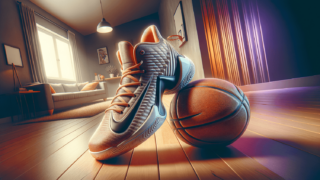
Have you ever wondered how elite basketball players make it look so easy to glide past defenders and score with finesse? Well, the secret ingredient is ‘space’ – and no, we’re not talking about the galaxy here! In the realm of basketball, creating space is an essential skill that leads to impressive plays and keeps opponents guessing. So, whether you are a newbie wanting to develop this craft, a seasoned player seeking to enhance your offensive game, or simply a fan looking to understand the art of basketball better, our blog post, “How to Create Space in Basketball,” serves as your roadmap to success. Let’s decode this hoop-essential and dive into the fascinating world of strategic footwork and timely play adjustments that pave the way for those highlight-worthy moments on the court.
How to Create Space in Basketball?
Creating space in basketball involves a combination of proper body positioning, efficient footwork, and tactical play execution. Key elements include ball handling techniques such as dribbling, changes of speed, and direction, as well as the effective use of screens and off-ball movements. Players must also develop a sense of court awareness, read and anticipate defensive movements, and utilize shot fakes or pass fakes to manipulate the defender. By mastering these skills and making them a part of your game, you’ll be able to generate enough space to create high-percentage scoring opportunities for yourself and your teammates.
Master the Art of Dribbling and Ball Handling
Ball handling is the backbone of space creation in basketball. With precise dribbling skills, you can maintain possession and manipulate defenders to create separation. Here are a few dribbling techniques to sharpen:
1. Low Dribble:
By keeping the dribble low, you make it difficult for the defender to steal the ball. The lowered center of gravity helps you maintain balance and control, allowing quick changes in direction when necessary.
2. Crossover Dribble:
The crossover dribble involves switching the ball between your hands while changing direction. A swift crossover can leave a defender in the dust, carving out the space needed for a well-timed shot or pass.
3. Behind-the-Back Dribble:
This flashy move enables you to change direction while protecting the ball from the defender. While it’s slightly more challenging to execute, it can become a powerful weapon in your arsenal when perfected.
4. Hesitation Dribble:
The hesitation dribble is all about deception. Slow down your dribble momentarily to make the defender believe you’re about to stop; then, explode past them, creating space and forcing them to react.
Utilize Changes in Speed and Direction
Being unpredictable is crucial in creating space in basketball. By varying your speed and direction, you leave defenders guessing and reacting to your movements, giving you the upper hand.
1. Stop-and-Go Move:
This entails abruptly stopping and then accelerating past the defender. By changing speeds, you force the defender to adjust, which can lead to hesitation or off-balance play, creating the space you need.
2. Change of Direction:
Switch directions unexpectedly while maintaining possession of the ball. This can include lateral movements or cutting back against the grain, leaving defenders scrambling to keep up.
3. Double Move:
A double move is a combination of two quick changes in direction. Examples include a step-back crossover or an in-and-out dribble followed by a spin move. The focus is to confuse the defense and create space for a clean shot or drive to the hoop.
Making Use of Screens and Off-Ball Movements
Much like chess, basketball requires strategic positioning and off-ball actions to create space. Screens and off-ball movements can help to scatter the opposing team and open scoring opportunities.
1. Setting Screens:
A screen is when a player positions themselves to block the path of a defender, enabling a teammate to move freely. The result is the creation of space for a potential shot, drive, or pass. Communication and timing are critical when setting screens effectively.
2. Off-Ball Cuts:
When a teammate has the ball, make strategic, well-timed runs towards the basket or unoccupied space on the court. By actively moving without the ball, you can draw defenders away from the ball-handler, allowing them to exploit open areas and create clean looks at the basket.
3. Backdoor Cut:
Backdoor cuts are a clever way to create space by moving behind defenders. Start by pretending to move away from the basket, then quickly reverse course and cut towards the hoop. If executed well, you’ll receive the ball with an open lane for an easy bucket.
Develop Court Awareness and Anticipation
Creating space in basketball requires intelligence and instinct. By understanding your surroundings and anticipating defensive movements, you can react quickly to exploit any openings that arise.
1. Study Your Defender:
Pay attention to the defender’s stance, foot positioning, and overall aggressiveness. Exploit any weaknesses, such as over-committing or leaning too much in one direction, to create space and gain an advantage.
2. Read the Help Defense:
Identify where help defense is likely to come from and adjust your play accordingly. For instance, if you drive to the hoop and see a help defender coming, you can kick out the ball to an open teammate for a clean shot.
3. Visualize and Predict:
As you gain experience, you’ll develop the ability to visualize how defensive players are likely to react to your movements. Leveraging this foresight can help you stay one step ahead of your opponents and create space on demand.
Incorporate Shot Fakes and Pass Fakes
Fakes are a critical component in space creation, forcing defenders to commit to a play that never materializes. Incorporate fakes into your game to keep defenders on their toes and create valuable space.
1. Shot Fake:
This involves mimicking the shooting motion but not releasing the ball, prompting your defender to leave their feet or lunge forward. Once they do, dribble past them or sidestep for an open shot opportunity.
2. Pass Fake:
Similar to a shot fake, a pass fake tricks defenders into thinking you’re about to pass the ball. As they shift their focus, take advantage of that brief moment to create space and make a play.
Be Creative and Relentless
Creating space in basketball is an ever-evolving process that demands constant adaptation. Be creative and relentless in your approach, continually learning from each play and honing your craft.
1. Experiment with New Moves:
Incorporate new moves and techniques to keep your game fresh and unpredictable. Whether it’s a new variation of a crossover or a unique spin on a backdoor cut, mix it up to keep defenses guessing.
2. Analyze Your Favorite Players:
Watch and learn from basketball legends and contemporary stars to see how they create space in various game situations. Study their footwork, ball handling, and decision-making to gather ideas for your own game.
3. Learn from Mistakes:
Embrace the learning process and understand that mistakes are inevitable. Use each error as an opportunity to grow and become better at creating space on the court.
Creating space in basketball is an essential skill for players of all levels. By focusing on improving your dribbling, altering your speed and direction, using screens and off-ball movements, and integrating shot fakes and pass fakes, you’ll watch your game flourish. Remember to stay creative, relentless, and open to learning, and you’ll be well on your way to mastering the art of space creation and becoming a true basketball maestro.
Improve Your Physical Conditioning
Physical conditioning plays a crucial role in creating space on the court. Building strength, speed, and agility will provide you with the necessary tools to maneuver around defenders and capitalize on openings. Here are some ways to enhance your physical fitness for basketball:
1. Strength Training:
Strength training enhances your power, stability, and balance on the court. Focus on exercises targeting the lower body, upper body, and core. Incorporate exercises like squats, lunges, push-ups, and planks into your workout routine to improve overall strength and performance.
2. Speed and Agility Drills:
Speed and agility are vital for creating space in basketball. Incorporate drills such as sprints, shuttle runs, and ladder drills into your training regimen to enhance your on-court acceleration, deceleration, and change of direction.
3. Plyometric Exercises:
Plyometric exercises, like box jumps and depth jumps, can improve your explosiveness and vertical leap. This increased explosiveness can help you elevate over defenders for shots and rebounds, or it can help propel you past defenders on offense.
Enhance Your Shooting Abilities
Being a reliable shooter creates a unique challenge for defenders, forcing them to guard you more closely, which in turn opens up opportunities to create space on the court. Here’s how you can improve your shooting abilities:
1. Perfect Your Mechanics:
Consistent shooting mechanics are critical for accuracy. Focus on your hand placement, body alignment, and follow-through to ensure you’re shooting the ball properly each time.
2. Develop a Quick Release:
A quick release allows you to shoot before the defender can recover and challenge the shot. By perfecting a rapid shooting motion, you’ll increase your chances of getting open looks at the basket.
3. Expand Your Shooting Range:
Becoming a threat from multiple spots on the court forces defenders to respect your shooting abilities, creating space for yourself and your teammates. Practice shooting from different areas, including mid-range, three-point, and even beyond the arc.
Enhancing Your Basketball IQ
A high basketball IQ is essential when attempting to create space on the court. Your understanding of the game’s nuances can help you see opportunities and exploit them before opponents can react. Here are a few tips:
1. Familiarize Yourself with Offensive Systems:
Understand the philosophy behind various offensive systems and how they create openings on the court. By knowing where the ball should be and anticipating the actions of your teammates, you can better exploit space when it appears.
2. Study Defensive Strategies:
By comprehending defensive schemes, you can anticipate the opposition’s movements and identify the space they leave vulnerable. Learn how to recognize common defensive sets, such as man-to-man, zone, and press defense, and devise strategies to exploit them.
3. Watch and Analyze Games:
Observing games, both on TV and in person, can deepen your understanding of how space is created and utilized in basketball. Analyze the movements of high-level players to gain insights into how they outmaneuver opponents and maximize space on the court.
By focusing on these additional areas – physical conditioning, shooting abilities, and basketball IQ – you’ll develop a well-rounded game that aids in creating space on the court. Combining these skills with the techniques mentioned earlier, you can elevate your basketball performance to new heights and become a dominating force on the hardwood.
Frequently Asked Questions
For those hungry for more knowledge on creating space in basketball, we’ve compiled a list of frequently asked questions to help quench your curiosity. Let’s delve into these common inquiries to expand your understanding further and enhance your court performance.
1. How can I improve my ball handling skills to create space in basketball?
Focus on practicing different dribbling techniques, such as low dribbling, crossover dribble, behind-the-back dribble, and hesitation dribble. Dedicate time to improving your control, speed, and ability to change directions while maintaining possession of the ball.
2. How important is speed in creating space on the court?
Speed is vital in creating space, as it allows you to exploit openings and force defenders to react to your movements. Combining speed with tactical stop-and-go moves or changes in direction can make you a challenging player to guard.
3. What role does footwork play in creating space?
Footwork is crucial in creating space as it enables you to move quickly, change direction, and maintain balance while executing various moves. By enhancing your footwork, you’ll be able to outmaneuver defenders and create opportunities for yourself and your teammates.
4. How can I use screens more effectively to create space?
Work on your communication and timing when setting screens. Understand when and where to set a screen based on your teammates’ positions, and ensure your teammates know your intentions. Setting screens with purpose and precision will create more space for offensive opportunities.
5. How can I better anticipate defensive movements to create space?
Study your defenders and their tendencies, read help defense rotations, and visualize defensive movements based on game situations. As you gain experience and basketball knowledge, you’ll develop the ability to predict and exploit defensive movements, leading to effective space creation.
6. How can I practice shot fakes and pass fakes to enhance my game?
Integrate shot fakes and pass fakes into your practice routines, focusing on making your fakes as realistic as possible. Work on the effectiveness of your fakes in one-on-one and team drills, constantly assessing and refining your technique.
7. What kind of physical conditioning exercises will help me create space in basketball?
Target strength training, speed and agility drills, and plyometric exercises to build a strong foundation for creating space. Focus on exercises that improve lower body, upper body, and core strength, as well as those that develop speed, change of direction, and explosiveness.
8. How can I use my shooting abilities to create space on the court?
Develop consistent shooting mechanics, hone your quick release, and expand your shooting range to keep defenders honest. By being a threat from multiple areas on the court, you’ll force defenders to guard you more tightly, creating space for offense in the process.
9. Are there specific drills I can practice to improve my ability to create space?
Yes, practice one-on-one and two-on-two drills, focusing on your dribbling, footwork, screens, cuts, and fakes. These drills will hone your ability to read and react to defensive movements, ultimately helping you create more space in game situations.
10. How can I increase my basketball IQ to become more effective at creating space?
Familiarize yourself with various offensive and defensive systems, watch and analyze basketball games, and incorporate the insights you gain into your strategic thinking. By enhancing your basketball IQ, you’ll develop a deeper understanding of space creation and be able to capitalize on opportunities more effectively.
Featured Posts
- No pillar pages found.





